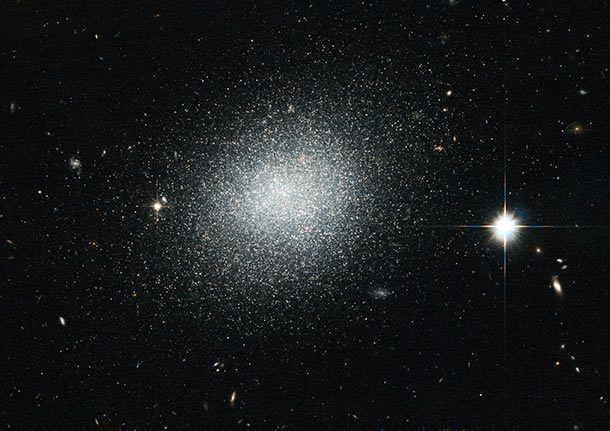Create a free profile to get unlimited access to exclusive videos, sweepstakes, and more!
A mini star factory lost in the sky

You'd think that with all our fancy equipment and technology, all the nearby galaxies in the Universe would've been spotted by now. But it turns out that's not the case. Some galaxies are very faint -- small, with few stars -- making them tough to find even when relatively speaking they're in our neighborhood.
So say hello to our newly-discovered neighbor, UGC 4597!
[Click to galactinate.]
UGC 4597 is a dwarf galaxy. Galaxies like our Milky Way have billions or hundreds of billions of stars, but dwarf galaxies have stars numbering in the millions. That's why it remained undiscovered until just a few years ago -- it turned up in a survey taken in 2008! Astronomers were looking for dwarf companions to the splashy spiral galaxy M81 located about 12 million light years away, and dinky UGC 5497 showed up.
The image above was taken by Hubble in late 2009. Of course, in this shot it looks obvious enough, but this only shows a teeny portion of the sky. Because it's so close to us, the entire M81 group of galaxies covers an area of the sky something like 20 times the size of the full Moon -- thousands of times the size of this diminutive dwarf. That's how it remained undiscovered for so long.
The image is a combination of two separates shots, one in visible light and one in near-infrared. The stars look very blue, with very few being red. Without a third image taken in bluer light it's hard to be completely sure, but the color here most likely means that most of these stars are young, created in a wave of star formation a few million years ago. Just above and to the right of center of the core of the galaxy is a reddish patch; I thought initially that might be a gas cloud of some sort, but now I suspect it's a background galaxy. In the full-res version of the picture you can see dozens of distant galaxies littering the scene, typical for a Hubble picture. They're most likely hundreds of millions and even billions of light years away, far, far in the background.
That bright star on the right and the fainter one on the left are probably stars in the foreground, in our own galaxy. Sometimes that fact gets me even more than the rich science of the galaxies themselves: the depth of time and space we see in images like this. Nearby objects like local stars, medium-distance objects like neighborhood galaxies, and then mind-crushingly distant galaxies so far away that the light we see from them left when the newest evolutionary invention on Earth were organisms with more than one cell!
Astronomy may be all about looking out into the Universe, but it's the perspective on ourselves that always stirs my mind.
ESA/Hubble & NASA
Related Posts:
- Desktop Project Part 16: A dinky galaxy with a big gas problem
- M81, up close and personal
- In galactic collisions, might makes right
- Pump up the galaxy



























